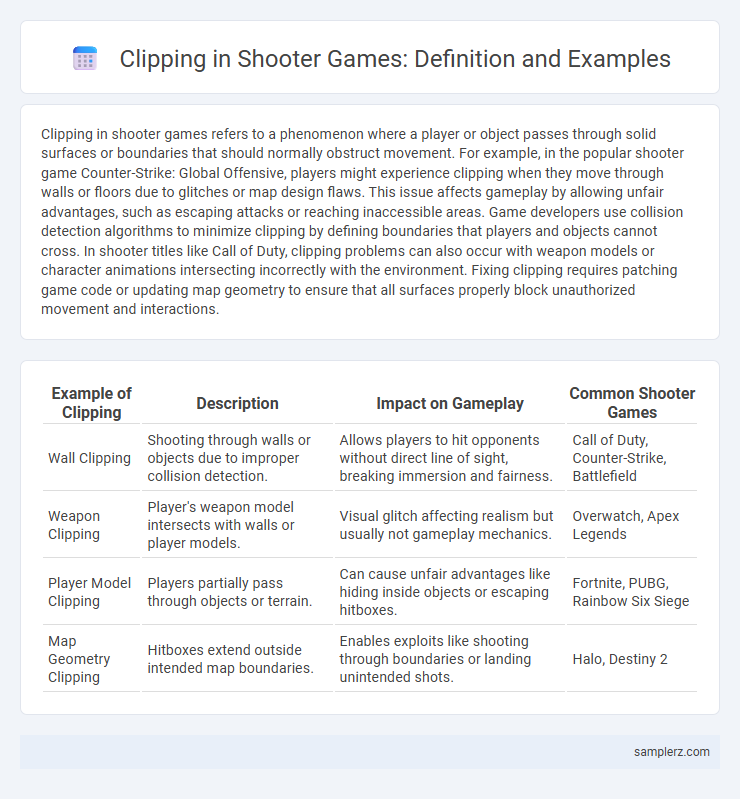Clipping in shooter games refers to a phenomenon where a player or object passes through solid surfaces or boundaries that should normally obstruct movement. For example, in the popular shooter game Counter-Strike: Global Offensive, players might experience clipping when they move through walls or floors due to glitches or map design flaws. This issue affects gameplay by allowing unfair advantages, such as escaping attacks or reaching inaccessible areas. Game developers use collision detection algorithms to minimize clipping by defining boundaries that players and objects cannot cross. In shooter titles like Call of Duty, clipping problems can also occur with weapon models or character animations intersecting incorrectly with the environment. Fixing clipping requires patching game code or updating map geometry to ensure that all surfaces properly block unauthorized movement and interactions.
Table of Comparison
| Example of Clipping | Description | Impact on Gameplay | Common Shooter Games |
|---|---|---|---|
| Wall Clipping | Shooting through walls or objects due to improper collision detection. | Allows players to hit opponents without direct line of sight, breaking immersion and fairness. | Call of Duty, Counter-Strike, Battlefield |
| Weapon Clipping | Player's weapon model intersects with walls or player models. | Visual glitch affecting realism but usually not gameplay mechanics. | Overwatch, Apex Legends |
| Player Model Clipping | Players partially pass through objects or terrain. | Can cause unfair advantages like hiding inside objects or escaping hitboxes. | Fortnite, PUBG, Rainbow Six Siege |
| Map Geometry Clipping | Hitboxes extend outside intended map boundaries. | Enables exploits like shooting through boundaries or landing unintended shots. | Halo, Destiny 2 |
Understanding Clipping in Shooter Games
Clipping in shooter games occurs when a player's character or projectiles pass through walls, objects, or other boundaries that should block movement or damage, often due to collision detection errors. This issue can disrupt gameplay balance by allowing unfair advantages such as shooting through solid surfaces or escaping enemy fire. Developers optimize collision meshes and implement robust hitbox systems to minimize clipping and ensure a fair, immersive gaming experience.
Common Clipping Glitches in Popular Shooters
Common clipping glitches in popular shooters like "Call of Duty" and "Counter-Strike" often involve players being able to shoot through walls or objects due to improper collision detection. These exploits allow players to gain unfair advantages by hitting enemies through cover or map boundaries. Developers regularly patch these issues to maintain game balance and competitive fairness.
Classic Examples of Map Clipping in FPS Titles
Classic examples of map clipping in FPS titles include players exploiting boundaries in games like Counter-Strike where they shoot through thin walls or objects not intended to block bullets. In Call of Duty, map clipping allows players to access out-of-bounds areas by passing through or standing inside geometry, gaining unfair sightlines or cover. Quake and Halo also feature notorious clipping spots where players bypass level design restrictions, enabling unconventional strategies or glitches.
How Clipping Affects Competitive Gameplay
Clipping in shooter games occurs when a player's model or hitbox partially passes through walls or objects, allowing them to shoot or be shot unfairly. This mechanic disrupts competitive gameplay by providing unintended cover or visibility advantages, undermining skill and strategy. Developers must address clipping issues to maintain fair environments and ensure player trust in competitive settings.
Famous Clipping Exploits in Esports History
In shooter games, clipping exploits occur when players pass through or shoot objects that normally block movement or bullets, gaining unfair advantages. One famous example is the use of wall clipping in Counter-Strike: Global Offensive by professional players to eliminate opponents from behind cover, notably during the ESL One Cologne 2016 tournament. These exploits disrupt competitive integrity and have led to stricter game patches and enforcement in esports leagues worldwide.
Differences Between Intentional and Unintentional Clipping
Intentional clipping in shooter games occurs when developers deliberately allow characters or objects to pass through certain surfaces to enhance gameplay or reduce frustration, such as shooting through thin walls for strategic advantage. Unintentional clipping, on the other hand, results from programming errors that cause characters or projectiles to improperly intersect with geometry, leading to immersion-breaking glitches like players getting stuck inside objects. Recognizing these differences helps in diagnosing gameplay balance issues versus technical bugs in competitive shooters like Call of Duty or Battlefield.
Player Tactics: Using Clipping for Tactical Advantage
Players in shooter games exploit clipping by positioning their characters partially inside walls or objects, allowing them to gather intel without full exposure. This tactic often reveals enemy movements while minimizing the risk of being targeted. Mastering clipping provides a strategic edge by enabling surprise attacks and safer reconnaissance.
Game Developer Responses to Clipping Issues
Game developers address clipping issues in shooter games by implementing advanced collision detection algorithms that accurately model player and environment interactions to prevent objects from passing through each other. They also release timely patches and updates that fix specific clipping bugs reported by the community, enhancing gameplay fairness and immersion. Utilizing player feedback, developers optimize hitbox configurations and map geometry to minimize clipping anomalies in competitive multiplayer environments.
Impact of Clipping on Game Fairness and Balance
Clipping in shooter games occurs when a player's model or weapon unintentionally passes through walls or objects, giving an unfair sight or shooting advantage over opponents. This exploit disrupts game fairness by allowing players to bypass map boundaries and engage in combat from unintended positions, compromising competitive balance. Developers must address clipping issues promptly to maintain integrity and ensure all players compete on equal footing.
Preventing Clipping: Best Practices for Shooter Developers
Preventing clipping in shooters involves implementing accurate hitbox boundaries and using advanced collision detection algorithms to ensure players and objects do not unintentionally pass through walls or terrain. Developers optimize level design by incorporating occlusion culling and physics-based barriers that maintain immersion without compromising gameplay fluidity. Regular playtesting and leveraging tools like spatial partitioning systems further enhance clipping prevention and player experience.

example of clipping in shooter Infographic
 samplerz.com
samplerz.com